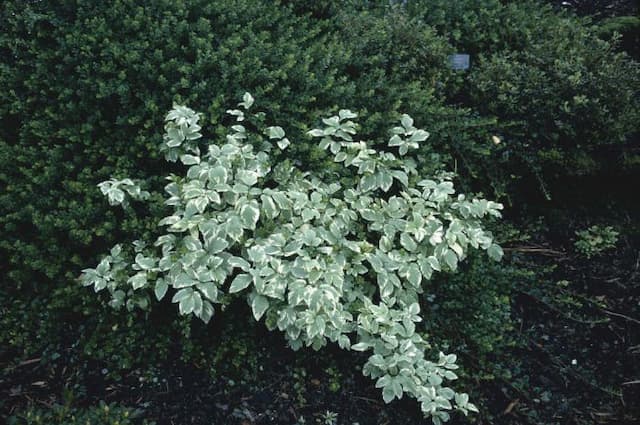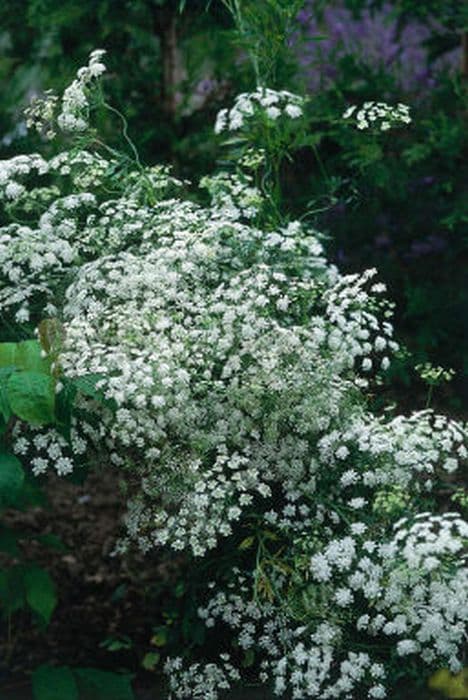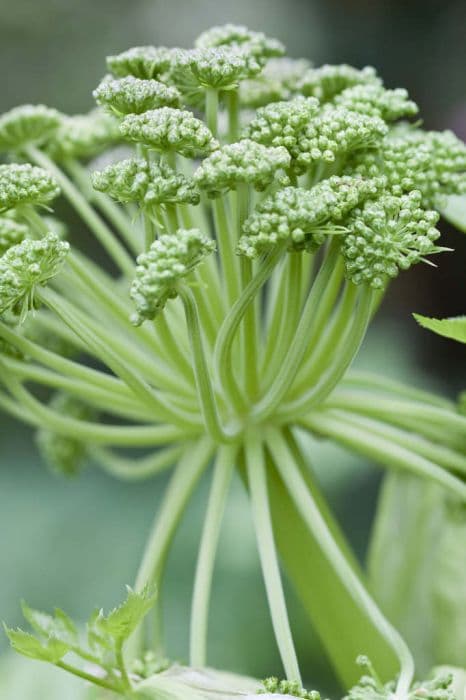Sea Holly Eryngium bourgatii Picos Amethyst = 'Mackpam' (PBR)

ABOUT
Eryngium bourgatii Picos Amethyst, commonly known as Sea Holly 'Mackpam', is a striking plant known for its distinctive appearance. It features a rosette of basal leaves that are deeply lobed, with spiny edges and a hint of bluish-green in hue. As the plant matures, it sends up branching stems topped with flower heads that are quite eye-catching. These flower heads have a thistle-like shape and are composed of small, tightly-clustered blooms which usually exhibit a remarkable metallic blue or amethyst color. Surrounding the flower heads are spiky bracts that also carry a similar shade of blue or violet, giving the plant an exotic and somewhat dramatic look. The stems themselves are rigid and stand upright, often creating a spiky silhouette that adds texture to garden settings. The leaves and stems may also be variegated with white veining, adding to the ornamental value of the plant. Sea Holly 'Mackpam' presents an overall appearance that is both sturdy and decorative, making it a favored choice for adding visual interest to mixed borders, rock gardens, and coastal planting schemes. The unique coloration and shape of its flowers also make it a popular choice for use in cut flower arrangements, where its durability and unusual beauty are highly prized.
About this plant
 Names
NamesFamily
Apiaceae
Synonyms
Sea Holly, Mediterranean Sea Holly
Common names
Eryngium bourgatii Picos Amethyst, Eryngium bourgatii 'Mackpam'.
 Toxicity
ToxicityTo humans
Sea Holly is not commonly known to be toxic to humans. However, it is always good practice to handle plants with care and avoid ingesting any plant parts unless it is known to be safe.
To pets
Sea Holly is not well known for being toxic to pets. However, there are general risks associated with pets consuming non-food plants including gastrointestinal upset. Always monitor pets around plants and discourage them from eating ornamental vegetation.
 Characteristics
CharacteristicsLife cycle
Perennials
Foliage type
Deciduous
Color of leaves
Green
Flower color
Blue
Height
1.5 feet (45 cm)
Spread
1 foot (30 cm)
Plant type
Herb
Hardiness zones
5
Native area
Pyrenees
Benefits
 General Benefits
General Benefits- Ornamental Value: The Eryngium bourgatii 'Mackpam', commonly known as Sea Holly, boasts decorative, thistle-like flowers adding unique texture and a striking blue-purple hue to gardens.
- Drought Tolerance: Once established, Sea Holly is highly drought-resistant, making it ideal for xeriscaping and water-efficient gardening.
- Low Maintenance: This plant requires minimal care, is generally pest-free, and doesn't need frequent watering or fertilizing.
- Attracts Wildlife: The vivid flowers attract bees, butterflies, and other pollinators, which can enhance pollination in your garden.
- Long Blooming Season: Sea Holly has a lengthy flowering period from summer to early fall, providing interest over an extended season.
- Cut Flower Use: It is excellent for cutting and can be used in fresh or dried floral arrangements, maintaining its color and form.
- Deer Resistance: Typically, Sea Holly is not favored by deer, which can make it a good choice for gardens in areas with deer pressure.
- Soil Adaptability: Sea Holly can grow in a variety of soil types, including poor or rocky soils, as long as there is good drainage.
- Coastal Suitability: Its tolerance for salt and windy conditions makes it suitable for coastal gardens.
- Structural Interest: With its spiny bracts and distinctive shape, the plant can provide structural interest even in the winter landscape after blooms have faded.
 Medical Properties
Medical PropertiesThis plant is not used for medical purposes.
 Air-purifying Qualities
Air-purifying QualitiesThis plant is not specifically known for air purifying qualities.
 Other Uses
Other Uses- Sea holly, including the Eryngium bourgatii Picos Amethyst variety, can be used in floral arrangements for its distinctive spiky texture and metallic blue color to add visual interest and contrast.
- The tough, spiny leaves of sea holly can serve as a deterrent to garden pests and animals that might otherwise chew on more delicate plants when integrated into a garden border.
- As a decorative element in crafts, the dried flower heads of sea holly can be incorporated into wreaths or used to create unique botanical art pieces.
- Sea holly plants can function as a natural fence or barrier in a garden due to their prickly nature, which can discourage foot traffic through certain areas.
- The striking appearance of sea holly flowers makes them a popular choice for themed garden designs, such as xeriscaping or rock gardens, where their hardiness and alien-like form fit well.
- Sea holly can be used in sensory gardens, where their unique texture and form contribute to the tactile experience for visitors, especially the visually impaired.
- In coastal areas, the sea holly can be used for stabilizing sandy soils as they are tolerant to wind and can survive in less nutrient-rich conditions.
- The silvery-blue color of sea holly flowers can be a source of inspiration for color palettes in interior design and fashion.
- The sea holly plant can be photographed and used for botanical illustration purposes due to its intricate structure and form.
- Planting sea holly can be part of a biodiversity initiative as it can attract a range of pollinators like bees and butterflies to a garden environment.
Interesting Facts
 Feng Shui
Feng ShuiThe Sea Holly is not used in Feng Shui practice.
 Zodiac Sign Compitability
Zodiac Sign CompitabilityThe Sea Holly is not used in astrology practice.
 Plant Symbolism
Plant Symbolism- Perseverance: Eryngium, commonly known as "Sea Holly," often grows in challenging environments and rocky ground, symbolizing the ability to thrive despite difficulties.
- Attraction: With its striking blue-violet color and unique spiky texture, Sea Holly is said to symbolize attraction and allure, drawing attention to its distinctive beauty.
- Protection: The thorny appearance of Sea Holly can be equated to a symbol of protection, suggesting a defense mechanism against harm and negative forces.
- Independence: The plant's capability to grow in poor soil conditions signifies independence and self-reliance, as it doesn't require much to sustain itself.
 Water
WaterSea Holly, specifically the Picos Amethyst variety, prefers soil that is well-draining and should be watered regularly but not excessively. Allow the top inch of soil to dry out before watering again, which typically means providing water about once a week. During hot and dry periods, slightly increase the frequency to prevent the soil from drying out completely. A good approach is to provide approximately one gallon of water per plant each week, adjusting as necessary for weather conditions and soil moisture levels.
 Light
LightSea Holly thrives best in full sun conditions, where it receives at least six hours of direct sunlight daily. Planting it in a location that provides ample sunlight will ensure the most robust growth and flower production. Avoid placing it in areas with too much shade, as this can lead to poor growth and fewer blooms.
 Temperature
TemperatureSea Holly can tolerate a range of temperatures and is considered hardy. It performs best in temperatures that hover between 60 and 80 degrees Fahrenheit but can survive in temperatures as low as 0 degrees and as high as 90 degrees Fahrenheit. Ideally, aim to maintain temperatures within this range for optimal growth.
 Pruning
PruningSea Holly benefits from occasional pruning to remove spent flowers and encourage new growth. Prune back the faded flowers in late summer or fall to tidy up the plant and potentially prompt a second flush of blooms. It is not necessary to prune frequently; once a year after flowering is adequate. Pruning also helps maintain a compact, attractive shape and can prevent self-seeding if not desired.
 Cleaning
CleaningAs needed
 Soil
SoilThe best soil mix for Sea Holly (Eryngium bourgatii 'Picos Amethyst') should be well-draining, sandy or loamy with some gravel or perlite for improved drainage. The soil pH should be neutral to slightly alkaline, ideally ranging between 6.0 and 7.5.
 Repotting
RepottingSea Holly (Eryngium bourgatii 'Picos Amethyst') should be repotted every 2-3 years or when roots become crowded in the current container. Early spring is the best time for repotting.
 Humidity & Misting
Humidity & MistingSea Holly (Eryngium bourgatii 'Picos Amethyst') is a drought-tolerant plant that prefers low to moderate humidity levels; it does not require high humidity and can thrive in dry air conditions commonly found in most home environments.
 Suitable locations
Suitable locationsIndoor
Provide bright light, well-draining soil, and minimal water.
Outdoor
Plant in full sun, well-drained soil; water sparingly.
Hardiness zone
5-9 USDA
 Life cycle
Life cycleEryngium bourgatii 'Picos Amethyst' begins its life cycle as a seed, germinating in spring under suitable conditions of moisture and temperature. The sprout then develops into a rosette of basal leaves before sending up a flowering stalk, typically in its second year. During the summer, intricate amethyst-colored flower heads surrounded by spiky bracts bloom, attracting pollinators such as bees and butterflies. After pollination, the flowers turn into seed heads, which then dry and release seeds for dispersal, completing the reproductive stage of the plant. As a perennial, the plant's foliage dies back in the fall and it enters a period of dormancy during the winter, surviving off stored energy in its root system. In the subsequent spring, the plant emerges again from the same rootstock, repeating the cycle.
 Propogation
PropogationPropogation time
Spring to Early Summer
Propogation: The most popular method of propagation for Sea Holly, Eryngium bourgatii Picos Amethyst 'Mackpam', is by seed. Sowing can be done in late winter to early spring, scattering the seeds thinly over a tray of well-drained soil mix, barely covering them with soil. The tray should then be placed in a cold frame or protected outdoor area, as some cold stratification can improve germination rates. Once the seedlings emerge and reach a sufficient size, they can be potted on into individual containers to grow on before being transplanted into the garden after all risk of frost has passed. It's essential to keep the soil consistently moist but not waterlogged during germination and early growth.









